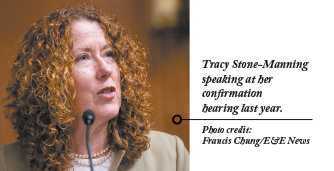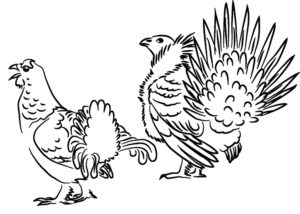 E&E NEWS
E&E NEWS
“The Bureau of Land Management is working on changes to sage grouse protection plans and a new rule governing livestock grazing on federal land,” said Tracy Stone-Manning, the Bureau Director
 E&E NEWS PM | Bureau of Land Management Director Tracy Stone-Manning told a ranching advocacy group today that the bureau will soon propose amendments to sweeping federal greater sage grouse plans covering millions of acres in an effort to save the bird.
E&E NEWS PM | Bureau of Land Management Director Tracy Stone-Manning told a ranching advocacy group today that the bureau will soon propose amendments to sweeping federal greater sage grouse plans covering millions of acres in an effort to save the bird.
Stone-Manning, speaking at the Public Lands Council’s online annual legislative conference by Zoom, also indicated that BLM is nearing completion of a new rule governing livestock grazing on more than 150 million acres of federal lands.
While Stone-Manning did not disclose specifics about the potential “amendments” to the sage grouse management plans, or details on the grazing rule, she did say that both are key components of an overarching effort by the Biden administration to make federal rangelands “resilient” to the effects of a warming climate and the ongoing drought plaguing much of the West.
“We’re working really hard to develop a suite of policies and management actions to manage drought, provide flexibility of use, restore ecologic function and conserve really important resource values in the face of climate change and extreme drought,” Stone-Manning said. “You all know this much better than I do because you are on the ground facing it every day.”
The extreme drought will mark how BLM manages grazing and other activities on federal lands in the future, she said.
The planned grazing rule follows efforts begun in early 2020 by the Trump administration to update the management of livestock and sheep grazing (Greenwire, Jan. 20, 2020).
Stone-Manning assured the ranching group today that BLM is working to incorporate “flexibility” in the upcoming grazing rule that would allow the bureau to respond to rapidly changing rangeland conditions. She said the bureau will work with the ranching community to ensure the health of the lands while still allowing them to be used for grazing, recreation, energy development and other uses.
“We recognize that actions taken to ensure the long-term sustainability of our public lands have the potential to create hardships for [the] folks who use public lands for your livelihoods, and folks who use it for recreational purposes,” she said. “Please know that we carry that and understand that in the foreground of our minds.”
But she added: “We do, of course, also know that failing to act in the face of prolonged, extreme droughts is going to create even worse impacts to our public lands and greater hardships over the long term, for both the lands and the users of those lands.”
She said she is going to be “briefed internally here in the next week or so on both the grazing rule and the sage grouse amendments, and the next steps that we’re ready to bring forward. And as I’m briefed, I promise I will turn to you and share what we know and the approach we expect to take.”
She said BLM is hiring a new senior-level employee to serve as a “liaison specific to the ranching community” on issues like rangeland health. “I’m thrilled that help’s on the way.”
On sage grouse, BLM last year launched a new effort to potentially amend the Obama-era protection plans approved in 2015 to address growing threats to the bird and its habitat over the past six years from climate change, persistent drought, wildfires and the spread of invasive plant species (Greenwire, 11.19.21).
President Biden’s fiscal 2023 budget request this week includes a request for $158.5 million for wildlife habitat management, most of which would go toward implementing conservation efforts for the greater sage grouse and the sagebrush steppe habitat the bird and hundreds of other species occupy (Greenwire, March 28).
Part of that money would also support “reviewing and updating sage grouse management in land-use plans to address population declines, new science, and climate change and improve the resilience of long-term conservation strategies,” according to a BLM review of the budget request.
The issue of sage grouse management in relation to the grazing is controversial, as grazing allotments sometimes overlap with grouse habitat.
If bird populations decline, and the sage grouse were to be listed for protection under the Endangered Species Act, it could have a significant impact on ranching on federal lands.
“The 2015 plans are a solid foundation for avoiding the need to list the greater sage grouse,” Stone-Manning said. “Let me say it out loud over again: The last thing we want is to list the greater sage grouse, which is why we are all working so hard.”
Kaitlynn Glover, PLC’s executive director, told Stone-Manning during a question-and-answer session after her speech that ranchers are concerned that BLM is not collaborating more closely on the potential amendments with Western states, most of which have their own sage grouse protection plans in place.
Stone-Manning pledged that the revised plans will be “state specific,” in that they will recognize the different geological and weather conditions in each state. She noted BLM has been consulting on the issue with the Western Governors’ Association.
“Yes, we are completely committed to it,” she said of working with the states. “We are talking one-on-one with governors about it, and we’re hearing them in their request that these [amendments] be state specific.”
GRAZING IMPACTS TO RANGELANDS
Stone-Manning’s speech to the ranching trade group today comes as environmental advocates this month ramped up calls for BLM to better manage livestock and sheep grazing to protect stressed federal lands.
The government watchdog group Public Employees for Environmental Responsibility (PEER) used BLM data to develop an interactive digital map that found 54 million acres of federal lands the bureau leased for livestock grazing failed land healthy standards for basic physical and biological factors (E&E News PM, March 14).
Glover dismissed the PEER analysis at the time as “wholly unscientific and disappointing.” She also did so after Stone-Manning’s speech.
Western Watersheds Project, which opposes large-scale grazing on federal lands, later released an online report showing that BLM failed to conduct a environmental analysis before renewing more than half of the grazing permits it approved last year (E&E News PM, March 23).
WWP said the likely result is degraded federal rangelands, including those that are home to sensitive wildlife species like greater sage grouse.
Both PEER and WWP shared the results of their separate analysis with Stone-Manning.
Stone-Manning was asked during the question-and-answer session about the reports and how BLM planned to address them.
While Stone-Manning did echo BLM’s comments earlier this month that the bureau “disagreed” with some of the conclusions in the PEER report, she acknowledged the backlog of environmental reviews on permit renewals, as required by the National Environmental Policy Act.
“The second study that was out there that talked about the stale NEPA on a bunch of our permits is true,” she said. “It is just not OK that everybody on this screen has permits, in some cases, that are 20 years old; it’s not OK.”
But she said she wants to move past the “finger-pointing” on which stakeholders are most to blame for failing rangeland conditions.
“Truly the good news is — and the shared value no matter who it is who’s talking about it— we all want for the future for these rangelands to be healthy, productive, that they have the ability to deliver that sustained yield that is truly our mission,” she said.

By Scott Streater
